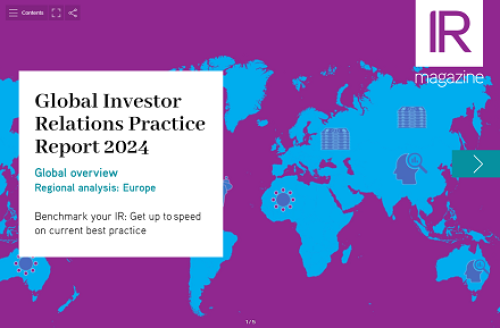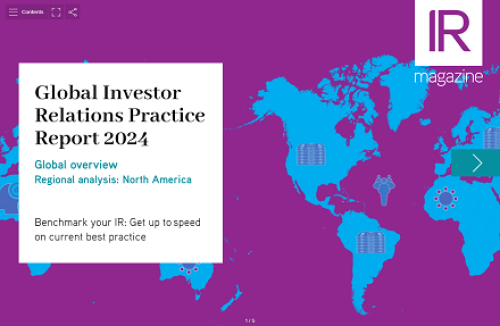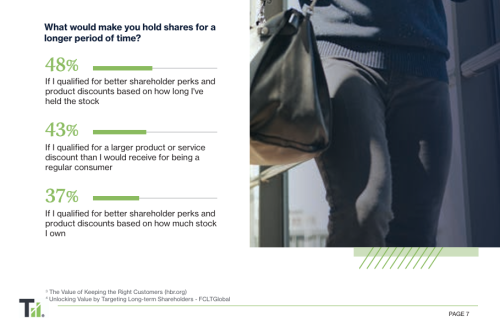The decisions behind taking a company private can be varied and complex, notes Kate Sidorovich, director of IR at eHealth
Faced with recent stock market volatility, challenges posed by the short-termism of institutional investors and decreased sell-side coverage of small and mid-cap issuers, some companies might question their status as publicly traded entities.
Their management teams will often find private equity funds happy to lend a sympathetic ear and discuss their options.
In fact, a firm whose valuation has suffered in the current market environment despite solid cash flow generation might find multiple private equity companies knocking on its doors.
IROs are likely to be involved in meetings with private equity funds and – clearly – it’s a tough subject for them, given that their position is likely to be eliminated as a result of a buyout, unless they can transition to a different function within the company.
But this shouldn’t affect the objectivity of their decision making. Participating in the process may even open new doors for career growth.
Adding value
One reason a company might go private is to create value beyond what the management team can realistically expect to achieve under the existing ownership structure.
This can happen when a company’s value-maximizing strategy involves a sacrifice of the near-term earnings growth.
Diversification into new markets or products, for example, requires a shift of managerial and financial resources toward these new initiatives and can initially jeopardize margins.
Institutional investors are becoming increasingly short-term oriented and often have little patience for ‘down quarters’, even if they represent a temporary bump on the road to a potentially meaningful upside.
Investing in a new business area requires embracing a conceived strategy and a certain degree of faith, on the part of shareholders, in management’s ability to execute and generate acceptable returns on their investment.
Shareholders’ skepticism may be expected in some cases as the diversification strategy might take management outside of its comfort zone.
In these cases, private equity investors can take a longer-term approach to valuing the company and offer the existing shareholders an attractive premium to current share price, while affording management more operational flexibility to pursue strategic plans away from the spotlight of the public market.
The Street also tends to be skeptical of acquisitions, so a company whose growth strategy involves plans for a meaningful acquisition or a series of tuck-in acquisitions might generate dissent within its shareholder base.
Many acquisitions are not immediately accretive and take time to prove their strategic merit and value.
Again, in these cases a longer-term approach by certain private equity investors might align better with management’s outlook than the shorter-term investment horizon of public shareholders.
In a nutshell, going private can sometimes allow companies to take bigger risks and pursue longer-term growth without alienating their shareholders.
Signs of success
One recent example of successful going-private transactions is BankRate, a leading personal finance website.
In 2008 and 2009 it faced deteriorating market conditions as a result of the financial crisis, which hit the two key drivers of its revenues: online advertising activity by banks and consumer interest in financial products.
In the last quarter before going private, its revenue declined more than 20 percent and net income declined more than 50 percent.
The board felt that if adverse conditions continued, they could further erode shareholder value and make it more difficult for the company to grow, compete for acquisitions and retain key employees.
Investors were also concerned with BankRate’s high exposure to the challenging mortgage sector, so in August 2009 BankRate was taken private by Apax Partners, a global private equity firm, at approximately 18 percent premium to the 10-day trading average.
Just two years later, BankRate returned to public markets as the largest lead-generation platform in consumer finance.
While private, the firm focused on diversifying its business from a predominantly mortgage advertising company to serving multiple personal finance channels through a variety of online ad types.
It also invested in technology, including providing more customization for consumers and better targeting for financial institutions.
This was accomplished through a combination of organic growth and two important acquisitions with a combined deal value of approximately $350 mn.
The company now has more scale, with quarterly revenues and EBITDA in the second quarter of 2011 tripling the rate from the second quarter of 2009.
BankRate also invested in technology, which includes providing more customization for consumers and better targeting for financial institutions.
Given the changes implemented by the management and the improved market conditions, BankRate is now a high-growth company with attractive margin structure and strong market position.
Taking a wrong turn
A privatization can also be done for all the wrong reasons, such as when the company is undervalued due to asymmetry of information, which occurs when the management and the IRO fail to properly communicate the company’s existing strategy, growth catalysts and cash deployment plans.
In this case, instead of contemplating going private, a company should form a task force to review its investor messaging, regularly reported metrics, periodic filings, corporate presentations and other pertinent investor-facing materials.
An undervalued analysis can also occur when the company has limited sell-side following. While the management has less control over this, there are various things IROs can do, including educating sell-side analysts in their sector even if they don’t cover the company, and exploring services of independent providers of non-deal roadshow services and pay-for-play coverage.
Another dubious reason for going private is to avoid regulatory compliance. In the post-Enron era of enhanced regulatory scrutiny, public companies had to step up their compliance efforts and incur higher expenses associated with such activities.
But many of the new regulatory requirements provide for effective internal controls and are good practice regardless of whether the company is public or private.
In fact, many companies that go private choose to remain compliant with SEC requirements and continue to get audited to be prepared for the exit strategy; some even continue to publish quarterly financial results.
Some management teams might also think not having to be accountable to institutional investors saves time on communication and provides for unlimited flexibility.
In reality, a company taken private often has to report to the private equity firm that led the transaction, which is typically a powerful and highly involved shareholder.
A private equity investor might have a longer-term focus and industry expertise sharp enough to appreciate management’s growth strategy, but all managerial actions will be stringently evaluated against the long-term goals set for the company.
When it all goes wrong
For each success story, alas, there is a Chicago Tribune, whose buyout added significant debt burden to an already over-stretched balance sheet at a time when the newspaper industry was undergoing major turmoil.
In 2007 the Tribune faced increasing competition from online publications, declining circulation and shrinking advertising revenues.
While its revenues were declining, especially in the classified ad category, the company remained solidly profitable, free cash flow-positive and was paying a dividend.
Arguably what it needed was an injection of new management talent that could help take the company into the new, internet-centric world.
Instead, it ended up with a team of executives with little direct experience in publishing and a significant debt burden, forcing the company into aggressive cost-cutting that made investing in new growth initiatives all but impossible.
Unlike CB and BankRate, the Tribune did not have a growth strategy it could have implemented more effectively as a private company.
Ultimately, when faced with the decision of whether to go private, a company’s management should review the rationale for such a transaction and consider whether any strategic benefits can be realized by avoiding the quarterly scrutiny of Wall Street – and whether these benefits outweigh the advantages of having access to public markets.
The company must also have a detailed road map in place for what it plans to accomplish as a private entity, before addressing the subject of valuation or any other transaction-related issues.
Without such a plan in place, a go-private transaction will simply move the risk from one group of stakeholders to another without benefiting the company.
That’s what happened at the Tribune when business risk and financial losses shifted from the company’s original shareholders to the banks that financed the buyout.
Kate Sidorovich is director of IR at eHealth.










